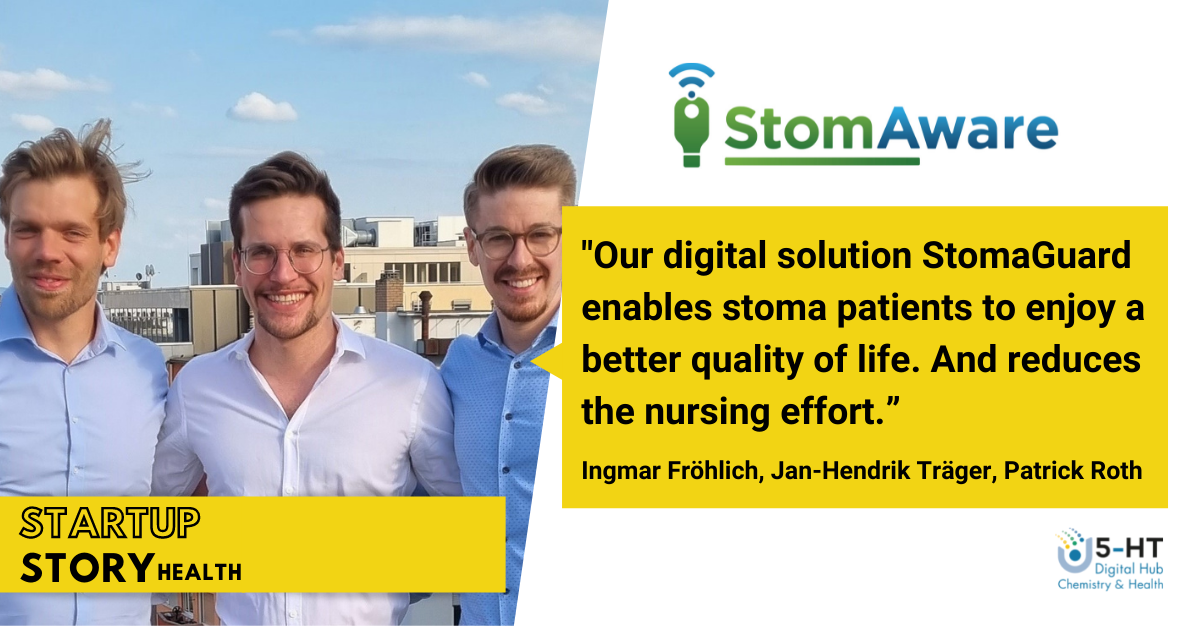How digitization can improve stoma therapy
Judith Hillen
As a nurse on a surgical station, Jan-Hendrik Träger has experienced for himself the problems that often arise in the therapy of stoma patients. Together with Patrick Roth and Ingmar Fröhlich, he therefore founded the startup ICE Tech (StomAware) in Kaiserslautern, which is part of the 5-HT network and aims to improve the care of stoma patients with a combination of software and hardware.
In an interview with 5-HT, the three founders share how their first product, StomaGuard, helps prevent the stoma bag from chipping - which not only reduces the need for care, but also contributes to a higher quality of life for patients.

The three founders of the startup ICE Tech (StomAware) (f.l.t.r.): Ingmar Fröhlich, Jan-Hendrik Träger and Patrick Roth
What problems do stoma patients have to deal with in everyday life?
Jan-Hendrik Träger: A stoma is an artificial intestinal outlet that is placed on the abdomen, along with a bag that collects digestive secretions. Once this pouch reaches a certain level, it must be emptied. Otherwise, it may burst, because not only digestive secretions come out of the intestine, but also air, so that the bag inflates over time. Especially in the initial phase, many stoma patients therefore develop sleep disorders. For many, it's also a challenge to navigate public spaces when they don't know where the nearest restroom is. We've talked to patients who say they always carry a spare set of clothes because they're afraid the pouch will flake off. Because this topic is extremely shameful, many stoma patients withdraw from public life. That's why we want to enable those affected to enjoy a better quality of life with the help of a digital solution.
How can stoma patients gain better control over their stoma bag with your product?
Jan-Hendrik Träger: Our StomaGuard solution offers patients an additional level of control without them having to actively do anything. A sensor is attached to the ostomy bag that continuously measures the fill level of the bag and transmits the data to a mobile app. In this app, patients can individually set the fill level at which they want to be notified. For example, they can say: When exercising, the cell phone should ring when the pouch is 50 percent full, but at night it's enough for me to know when it's 80 percent. However, the StomaGuard is not only intended to provide this control function, but also to create additional added value, for example with a toilet finder that allows users to find public toilets in their immediate area, or with therapeutic approaches. Depending on how often the bag is emptied, the app can, for example, give the tip to eat more fiber and directly suggest suitable recipes to improve digestion.
How can StomaGuard also help to improve the care of stoma patients in the clinical setting?
Jan-Hendrik Träger: When the stoma bag of a patient in hospital bursts off, it is not only unpleasant for the patient, but also means a lot of work for the nursing staff. This is because the nursing staff have to reassure the patient, help him with hygiene, re-make his bed and possibly apply new wound bandages. With a tablet in the ward room, on which the condition of all the stoma bags on the ward can be monitored with the help of StomaGuard, we can considerably improve the quality of care and significantly reduce the workload for nursing staff.
Why did you found your startup and develop StomaGuard?
Jan-Hendrik Träger: I am a specialist nurse myself and experienced the problem of the stoma bag chipping off for the first time during my training on a visceral surgery ward. So together with Patrick, who studied industrial engineering with a focus on entrepreneurship, I worked out how we could tackle this problem. During the summer school of the Kaiserslautern startup office, we developed an initial business model, but quickly reached our limits when it came to the question of technical implementation. That's why we brought Ingmar into the team, who studied electrical engineering and therefore has the necessary knowledge in the hardware field.
How far have you got with the development of StomaGuard?
Ingmar Fröhlich: At the moment, we are finishing the development of our prototype, which we want to test with the first patients before the end of this year. How quickly we can go to market depends on whether we find an investor or development partner in the near future, which would significantly speed up development.
Who are the target groups you have in mind for your solution?
Jan-Hendrik Träger: In the first step, we want to approach end customers - we are already in contact with some stoma patients. In the second step, our solution is also interesting for the clinical setting. Therefore, we want to introduce StomaGuard to clinics within the framework of individual contracts, for which we are also already in contact with some stoma therapists. In the long term, we are aiming to obtain funding from the health insurance system.
StomaGuard is the first product under your StomAware brand. With which other products do you want to improve the care of stoma patients in the future?
Jan-Hendrik Träger: There are a number of problems in the provision of aids, especially in stoma therapy, that we can solve with the help of digitization. The bursting of the pouch is the first problem we have identified. But just as problematic is the hydrocolloid bandage used to secure the ostomy pouch to the abdominal surface, because this is where leaks occur more often, allowing digestive secretions to escape. In the pouch itself, it is also common for the built-in filters to become clogged with fluids. We can solve all these problems with a combination of hardware and software.
Can your technology also be used in other areas of medical device supply?
Jan-Hendrik Träger: The level measurement technology that we are currently developing for the ostomy bag can also be transferred to other flexible bags in medical applications. In intensive care units, nurses still empty urine bags every hour and note the fluid volumes. With drains running at critical points, they have to check every few minutes to see if blood suddenly rushes in. These are just two examples of use cases that we can support with our combination of hardware and software.
What do you hope to gain from being part of the 5-HT network?
Patrick Roth: For us, it is primarily interesting to get into conversation with potential investors. These can be private business angels as well as partners with whom we can jointly drive forward development. If, for example, we could cooperate with a large medical device manufacturer that already has distribution networks or production capacities, this would extremely accelerate the development of StomaGuard. We can imagine various cooperation models in this regard.
Ingmar Fröhlich: We also welcome input and feedback from users and those affected. In developing our product, it is very important to us that we understand and take into account the needs of the entire spectrum of customers - from self-users to family caregivers to professional caregivers.
Jan-Hendrik Träger: In general, external know-how is extremely valuable for us. That's why we are very much looking forward to exchanging ideas with other players from the 5-HT network.
5-HT Chemistry & Health Newsletter
Want the latest tech and industry news, events, relevant info from the ecosystem and more?
Subscribe to 5-HT Newsletter now Subscribe to 5-HT Newsletter now
Become part of the 5-HT Chemistry & Health
Exchange ideas with innovative startups and future-oriented companies in our ecosystem. We look forward to meeting you!